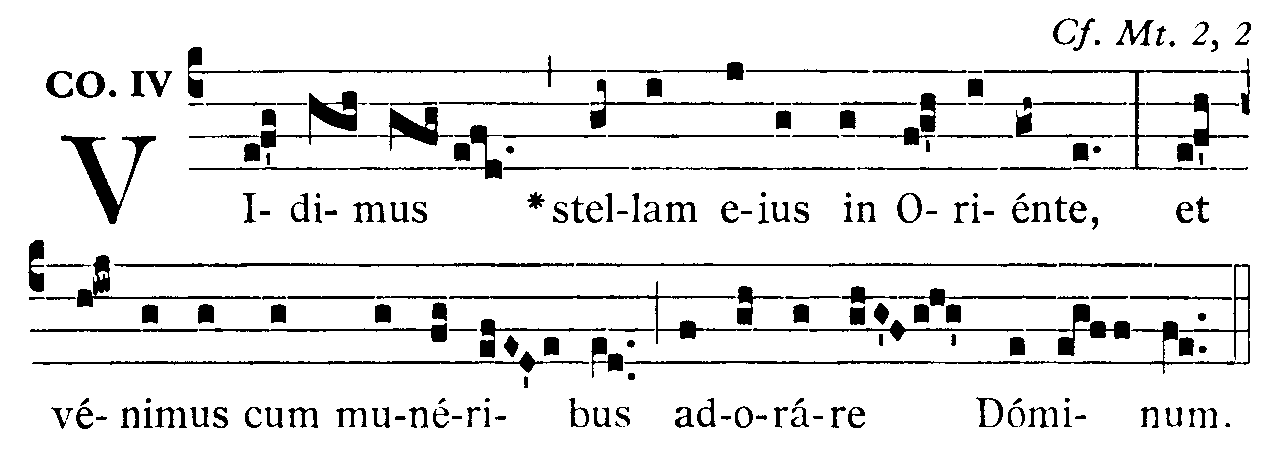Sollemnitas
Ubi sollemnitas Epiphaniæ non est de præcepto servanda, assignatur, tamquam diei proprio, dominicæ a die 2 ad diem 8 ianuarii occurrenti.
Ad Missam in Vigilia
Hæc Missa adhibetur vespere pridie sollemnitatis sive ante sive post I Vesperas Epiphaniæ.
Ant. ad introitum Cf. Bar 5, 5
Surge, Ierúsalem, et circúmspice ad oriéntem et vide
congregátos fílios tuos a solis ortu usque ad occásum.
Dicitur Glória in excélsis.
Collecta
Corda nostra, quǽsumus, Dómine,
tuae maiestátis splendor illústret,
quo mundi huius ténebras transíre valeámus,
et perveniámus ad pátriam claritátis ætérnæ.
Per Dóminum.
Dicitur Credo.
Super oblata
Súscipe, quǽsumus, Dómine, múnera nostra
pro apparitióne Unigéniti Fílii tui
et primítiis géntium dicáta,
ut et tibi celebrétur laudátio
et nobis fiat ætérna salvátio.
Per Christum.
Præfatio de Epiphania.
Ant. ad communionem Cf. Ap 21, 23
Cláritas Dei illuminávit civitátem sanctam Ierúsalem
et ambulábant gentes in lúmine eius.
Post communionem
Sacra alimónia renováti,
tuam, Dómine, misericórdiam deprecámur,
ut semper in méntibus nostris tuæ appáreat stella iustítiæ
et noster in tua sit confessióne thesáurus.
Per Christum.
Adhiberi potest formula benedictionis sollemnis.
Ad Missam in die
Ant. ad introitum Cf. Mal 3, 1; 1 Chr 29, 12
Ecce advénit Dominátor Dóminus;
et regnum in manu eius et potéstas et impérium.

Dicitur Glória in excélsis.
Collecta
Deus, qui hodiérna die Unigénitum tuum
géntibus stella duce revelásti,
concéde propítius, ut, qui iam te ex fide cognóvimus,
usque ad contemplándam spéciem tuæ celsitúdinis
perducámur.
Per Dóminum.
Ubi mos est, pro opportunitate, publicari possunt post Evangelium festa mobilia anni currentis iuxta formulam positam.
Dicitur Credo.
Super oblata
Ecclésiæ tuæ, quǽsumus, Dómine, dona propítius intuére,
quibus non iam aurum, thus et myrrha profértur,
sed quod eísdem munéribus
declarátur, immolátur et súmitur, Iesus Christus.
Qui vivit et regnat in sǽcula sæculórum.
Præfatio de Epiphania Domini.
Quando adhibetur Canon romanus, dicitur Communicántes proprium.
Ant. ad communionem Cf. Mt 2, 2
Vídimus stellam eius in Oriénte,
et vénimus cum munéribus adoráre Dóminum.

Post communionem
Cælésti lúmine, quǽsumus, Dómine,
semper et ubíque nos prǽveni,
ut mystérium, cuius nos partícipes esse voluísti,
et puro cernámus intúitu, et digno percipiámus afféctu.
Per Christum.
Adhiberi potest formula benedictionis sollemnis.
© Copyright – Libreria Editrice Vaticana
Messalino in PDF con letture in lingua italiana (da stampare su fogli A3 fronte/retro)
Missalette in PDF with readings in English (to be printed on A3 sheets, front/back)






